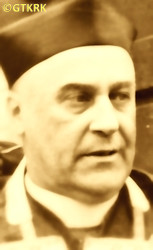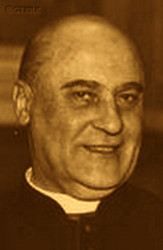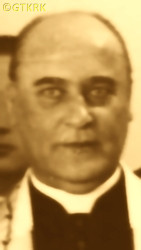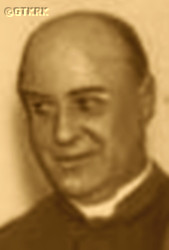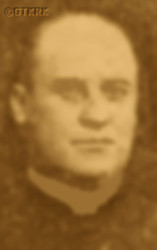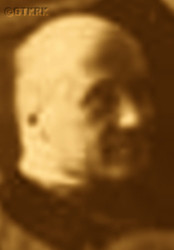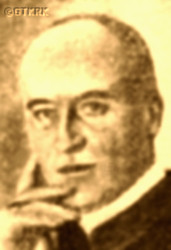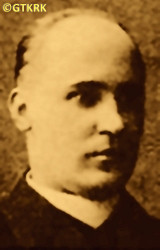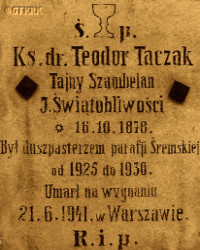Roman Catholic
St Sigismund parish
05-507 Słomczyn
85 Wiślana Str.
Konstancin deanery
Warsaw archdiocese, Poland
full list:
displayClick to display full list

searchClick to search full list by categories
wyświetlKliknij by wyświetlić pełną listę po polsku

szukajKliknij by przeszukać listę wg kategorii po polsku

Martyrology of the clergy — Poland
XX century (1914 – 1989)
personal data
surname
TACZAK
forename(s)
Theodore (pl. Teodor)
function
diocesan priest
creed
Latin (Roman Catholic) Church RCmore on
en.wikipedia.org
[access: 2014.09.21]
diocese / province
Gniezno and Poznań archdiocese (aeque principaliter)more on
www.archpoznan.pl
[access: 2012.11.23]
RC Military Ordinariate of Polandmore on
en.wikipedia.org
[access: 2014.12.20]
academic distinctions
Doctor of Sacred Theology
honorary titles
Papal super–numerary private honorary chamberlainmore on
en.wikisource.org
[access: 2020.12.11]
(1919)
Minor Canonmore on
en.wikipedia.org
[access: 2014.11.14]
(1909 – , St George RC collegiate church, Gnieznotoday: Gniezno urban gm., Gniezno pov., Greater Poland voiv., Poland
more on
en.wikipedia.org
[access: 2021.12.18])
„Polonia Restituta” Cross — 4th Class, Officer'smore on
en.wikipedia.org
[access: 2019.04.16]
(28.04.1926)
Gold „Cross of Merit”more on
en.wikipedia.org
[access: 2019.04.16]
(25.03.1938)
Badge of Honour of the Air and Anti–Gas Defence League, golden 1st class
(29.11.1938)
date and place
of death
22.06.1941

Warsawtoday: Warsaw city pov., Masovia voiv., Poland
more on
en.wikipedia.org
[access: 2021.10.09]
details of death
During secondary education at Germ. Königliches Katholisches Gymnasium (Eng. Royal Catholic Gymasium) in Ostrów Wielkopolski member of Polish clandestine self‐educational Thomas Zan Society — at some point also its chairman.
After the abdication on 09.11.1918 of the German Emperor William II Hohenzollern; after the signing on 11.11.1918 by the Allies and the Germans, in the staff wagon in Compiègne, at the headquarters of French Marshal Ferdinand Foch, of the armistice and ceasefire — which de facto meant the end of World War I; and also after the handover on 11.11.1918 by the Regency Council – operating in the so‐called Germ. Königreich Polen (Eng. Polish Kingdom) occupied by the Central Powers (Germany and Austria–Hungary) — of supreme command over the army to Brigadier Joseph Piłsudski and his appointment as Commander‐in‐Chief of the Polish Army, which de facto meant the rebirth of the Polish state, encompassing however only the Germ. Königreich Polen, i.e. the Polish territory under Russian rule until 1915, but excluding the lands of the Prussian partition; Greater Poland — as the Prussian Germ. Provinz Posen (Eng. Poznań Province) — was still formally part of the German state. Gniezno, the first historical capital of Poland, where ministered at the time, was the seat of the Germ. Kreis Gnesen (Eng. Gniezno District) in the Germ. Provinz Posen. A Soldiers' Council was established there as early as 10.11.1918. Gniezno was a strong garrison centre with several groups of barracks, were, among others, Germ. Infanterie–Regiments Nr. 49 (Eng. 49th Infantry Regiment), Germ. Infanterie–Regiment Nr. 357 (Eng. 357th Infantry Regiment) formed during the war, and Germ. Dragoner–Regiment Nr. 12 (Eng. 12th Dragoon Regiment) were stationed — and that’s why in the RŻ there were 3 Poles and 20 Germans. In the Workers' Council, however, which was established a day later, there were 18 Poles and 4 Germans. Both councils were founded on the model of similar ones established after the fall of the empire throughout Germany, but it was the County People's Council, established on 14.11.1918 at the appeal of the Polish Supreme People's Council NRL from Poznań, that began to gain greater importance.
When on 12.1918 it turned out that without an armed rebellion of the Poles, it would be impossible to achieve incorporation of the Greater Poland into an independent Polish state, informed the NRL about his brother Stanislav, who was staying with him in Gniezno, the first Pole — an officer of the German army — who in 11.1918 reported to the Polish Ministry of Military Affairs. And when the Greater Poland Uprising broke out on 27.12.1918, went with Stanislav to Poznań and, together with a member of the NRL, Adalbert Korfanty, persuaded Stanislav to become its first commander‐in‐chief. Returned to Gniezno, and there already on 29.12.1918, a 60‐person group of insurgents forced the German soldiers from the infantry barracks to leave them and leave the city. The railway station and the post office, Germ. Landratsamt (Eng. County Office), were also taken over, control of communications was secured. Immediately afterwards the dragoon barracks surrendered… At that time cooperated with one of the most famous insurgent chaplains from Gniezno, Fr Matthew Zabłocki, taking an active part in the insurgent clashes, in particular near the village of Zdziechowa, c. 7 km north of Gniezno, where the Germans, after withdrawing from the city, were strengthening. The Poles surprised the Germans and managed to force them to retreat, capturing, among other things, 500 light rifles, 12 heavy and a dozen light machine guns. Gniezno was free.
The Uprising ended on 16.02.1919 with the armistice in Trier, enforced by the victorious Entente states, under which the Polish insurgent Greater Poland Army was recognised as an allied army and a border was set, which „German troops were forbidden to cross”, leaving a large part of Greater Poland outside their influence. However, it was not until the Treaty of Versailles, concluded on 28.06.1919, that Greater Poland was awarded to Poland. It formally became part of Poland on 10.01.1920, after the ratification of the treaty by all parties.
After German invasion of Poland on 01.09.1939 (the Russians invaded Poland 17 days later) and start of the World War II, after start of German occupation, for the first time arrested by the Germans on 11.09.1939 and held as a hostage (in Gold Hall and Library Hall of the Old Town Hall, and next in Collegium Marianum building on Różana Str. in Poznań).
Released on 30.10.1939.
Arrested again on 09.11.1939, after confiscation by the Germans of St Martin church in Poznań and turning it into a stolen sacred artwork warehouse.
Held in the IL Glowna transit camp in Poznań for people being forcibly deported from the new German Germ. Reichsgau Wartheland province (or in KL Posen — Fort VII — concentration camp) and next in IL Bischofsfelden transit camp in Kazimierz Biskupi.
From there in 05.1940 deported to German‐run Germ. Generalgouvernement (Eng. General Governorate) where perished (on the day of German attack of their erstwhile ally, Russians).
cause of death
exile
perpetrators
Germans
sites and events
GeneralgouvernementClick to display the description, IL GlownaClick to display the description, Deportations from Reichsgau WarthelandClick to display the description, IL BischofsfeldenClick to display the description, KL PosenClick to display the description, Reichsgau WarthelandClick to display the description, «Intelligenzaktion»Click to display the description, Collective responsibility („Hostages”)Click to display the description, Ribbentrop‐MolotovClick to display the description, Pius XI's encyclicalsClick to display the description, Greater Poland UprisingClick to display the description, Thomas Zan SocietiesClick to display the description
date and place
of birth
16.10.1878Birth certification on:
photos.szukajwarchiwach.gov.pl
[access: 2025.08.19]

Mieszkówtoday: Jarocin gm., Jarocin pov., Greater Poland voiv., Poland
more on
en.wikipedia.org
[access: 2021.07.15]
parents
TACZAK Andrew
🞲 1840, Mieszkówtoday: Jarocin gm., Jarocin pov., Greater Poland voiv., Poland
more on
en.wikipedia.org
[access: 2021.07.15] — 🕆 09.09.1900, Mieszkówtoday: Jarocin gm., Jarocin pov., Greater Poland voiv., Poland
more on
en.wikipedia.org
[access: 2021.07.15]

WARASIECKA Balbina
🞲 1843, Mieszkówtoday: Jarocin gm., Jarocin pov., Greater Poland voiv., Poland
more on
en.wikipedia.org
[access: 2021.07.15] — 🕆 30.01.1900, Mieszkówtoday: Jarocin gm., Jarocin pov., Greater Poland voiv., Poland
more on
en.wikipedia.org
[access: 2021.07.15]
presbyter (holy orders)
ordination
19.03.1901

Gnieznotoday: Gniezno urban gm., Gniezno pov., Greater Poland voiv., Poland
more on
en.wikipedia.org
[access: 2021.12.18]
positions held
1940 – 1941
resident — Warsawtoday: Warsaw city pov., Masovia voiv., Poland
more on
en.wikipedia.org
[access: 2021.10.09]
1930 – 1939
parish priest — Poznańtoday: Poznań city pov., Greater Poland voiv., Poland
more on
en.wikipedia.org
[access: 2021.07.18] ⋄ St Martin the Bishop and Confessor RC parish ⋄ Poznańtoday: Poznań city pov., Greater Poland voiv., Poland
more on
en.wikipedia.org
[access: 2021.07.18] RC deanery — also: c. 1931‐1939 member of the Council of Parish Priests–Consultors of the Metropolitan Curia; c. 1931‐1939 pro‐synodal examiner; c. 1931‐1939 archbishop's deputy in disciplinary matters of the Archbishop's Theological Seminary; c. 1932‐1939 archbishop's delegate to the Higher Council of the Conference of St Vincent de Paul; c. 1932‐1939 member of the Supreme National Council of the Pontifical Society for the Propagation of the Faith and the Supreme National Council of the Pontifical Society of St Peter the Apostle; 1930‐1939 county inspector of religion classes in elementary schools; c. 1932‐1939 academic chaplain of youth at the University of Poznań; 1932‐1933 president of the Union Council of the Polish Male Youth Union; 1932 builder of the Parish House at St Martin Str.; 1930‐1931 president of the Board of the Archbishop Boarding Schools; from 1930 editor and from 1931 publisher of the Pl. „Tygodnik Kościelny parafii pw. św. Marcina” (Eng. „The St Martin Parish Church Weekly”); collaborator of Pl. „Roczniki Katolickie” (Eng. „Catholic Annals”)
1930 – 1939
priest — Poznańtoday: Poznań city pov., Greater Poland voiv., Poland
more on
en.wikipedia.org
[access: 2021.07.18] — academic
1925 – 1930
parish priest — Śremtoday: Śrem gm., Śrem pov., Greater Poland voiv., Poland
more on
en.wikipedia.org
[access: 2021.07.18] ⋄ Blessed Virgin Mary of the Assumption RC parish ⋄ Śremtoday: Śrem gm., Śrem pov., Greater Poland voiv., Poland
more on
en.wikipedia.org
[access: 2021.07.18] RC deanery — also: till 1929 headmaster of a private girls' gymnasium; till 1930 county inspector of religion classes in elementary schools; till 1930 president of the Board of the Archbishop Boarding Schools; 1928‐1929 editor of the parish weekly Pl. „Gość Niedzielny” (Eng. „Sunday Guest”); ca. 1926 president of the county Association for the Defense of the Western Borderlands
1925 – 1930
RC auxiliary military chaplain — Śremtoday: Śrem gm., Śrem pov., Greater Poland voiv., Poland
more on
en.wikipedia.org
[access: 2021.07.18] ⋄ garrison, Corps District OK No. VII Poznań, Polish Armed Forces — in the garrison there was a Reserve Infantry Cadet Battalion No. 7 [i.e. Reserve Infantry Cadet School No. 7 (1927‐1928) / Infantry Training Battalion OK No. VII (till 1927)]
1919 – 1925
dean — Metztoday: Metz arr., Mozela dep., Grand Est reg., France
more on
en.wikipedia.org
[access: 2022.07.18] ⋄ Polish Catholic Mission — minister to Polish emigrants and migrants
1916 – 1919
president — Gnieznotoday: Gniezno urban gm., Gniezno pov., Greater Poland voiv., Poland
more on
en.wikipedia.org
[access: 2021.12.18] ⋄ Archbishop's Metropolitan Court ⋄ Gniezno RC archdiocese
05.11.1915 – 1916
pro‐synodal judge — Gnieznotoday: Gniezno urban gm., Gniezno pov., Greater Poland voiv., Poland
more on
en.wikipedia.org
[access: 2021.12.18] ⋄ Archbishop's Metropolitan Court ⋄ Gniezno RC archdiocese
1915
vicar general — Gniezno RC archdiocese — Lat. „in spiritualibus”
1909 – 1919
Minor Canon — Gnieznotoday: Gniezno urban gm., Gniezno pov., Greater Poland voiv., Poland
more on
en.wikipedia.org
[access: 2021.12.18] ⋄ Collegiate Chapter ⋄ St George the Martyr RC collegiate church
1908 – 1919
professor — Gnieznotoday: Gniezno urban gm., Gniezno pov., Greater Poland voiv., Poland
more on
en.wikipedia.org
[access: 2021.12.18] ⋄ Archbishop's Theological Seminary — lecturer in canon law, moral theology and social issues; also: librarian of the seminary and chapter libraries; from 1909 fiscal procurator / treasurer and defender of the marriage bond at the Archbishop's Metropolitan Court; from 1917 member of the Union of Charity Societies „Caritas”; 1911‐1913 editor of „Apologetics' News” published in Poznań; from 1912 consistory counselor; from 1912 curator of the boys' boarding school; pro‐syndal examiner; censor of religious books (Lat. censores librorum); moderator of the Marian Sodality; c. 1916 extraordinary member of the Fraternal Aid Fund in Berlin and Charlottenburg, supporting Polish students in Germany; activist of the Committee of the People's Reading Rooms Society TCL; 1907‐1910 member of the Union of Polish Catholic Charity Societies
1904 – 1908
vicar–mansionaire — Poznańtoday: Poznań city pov., Greater Poland voiv., Poland
more on
en.wikipedia.org
[access: 2021.07.18] ⋄ St Adalbert the Bishop and Martyr RC parish ⋄ Poznańtoday: Poznań city pov., Greater Poland voiv., Poland
more on
en.wikipedia.org
[access: 2021.07.18] RC deanery — also: vice‐patron of the Catholic Society of Polish Workers; president of the „Dawn” Temperance Society
1903
vicar — Sławoszewtoday: Kotlin gm., Jarocin pov., Greater Poland voiv., Poland
more on
en.wikipedia.org
[access: 2021.07.18] ⋄ St Sophie RC parish ⋄ Jarocintoday: Jarocin gm., Jarocin pov., Greater Poland voiv., Poland
more on
en.wikipedia.org
[access: 2021.07.18] RC deanery
1903
vicar — Ostrów Wielkopolskitoday: Ostrów Wielkopolski urban gm., Ostrów Wielkopolski pov., Greater Poland voiv., Poland
more on
en.wikipedia.org
[access: 2021.06.07] ⋄ St Stanislav the Bishop and Martyr RC parish ⋄ Ostrów Wielkopolskitoday: Ostrów Wielkopolski urban gm., Ostrów Wielkopolski pov., Greater Poland voiv., Poland
more on
en.wikipedia.org
[access: 2021.06.07] RC deanery
1901 – 1903
PhD student — Münstertoday: Münster urban dist., Münster reg., North Rhine‐Westphalia state, Germany
more on
en.wikipedia.org
[access: 2021.07.18] ⋄ theology, Wilhelm University of Westphalia [i.e. Wilhelm University of Westphalia (from 1907) / Royal University of Theology and Philosophy (1902–1907) / Royal Theological and Philosophical Academy] (1843–1902) — PhD thesis Germ. „Dämonische Bessenheit, ein Kapitel aus der kath. Lehre von der Herrsch aft des Fürsten der Sünde u. des Todes” (Eng. „Demonic possession, a chapter from the Catholic doctrine of the dominion of the prince of sin and death”), public defense in 1903
1900 – 1901
student — Gnieznotoday: Gniezno urban gm., Gniezno pov., Greater Poland voiv., Poland
more on
en.wikipedia.org
[access: 2021.12.18] ⋄ philosophy and theology, Archbishop's Practical Theological Seminary (Lat. Seminarium Clericorum Practicum)
1897 – 1900
student — Poznańtoday: Poznań city pov., Greater Poland voiv., Poland
more on
en.wikipedia.org
[access: 2021.07.18] ⋄ philosophy and theology, Archbishop's Theological Seminary (Collegium Leoninum)
author of: Lat. „Ius matrimoniale ecclesiasticum alumnorum seminarii archiepiscopalis gnesnensis usui accommodavit…” (Eng. „Ecclesiastical matrimonial law for the use of alumni of the seminary in Gniezno…”), 1911, Gniezno, on manuscript rights; Lat. „Tractatus de Sacramento Poenitentiae alumnorum seminarii archiepiscopalis gnesnensis usui accommodavit…” (Eng. „Treatise on the Sacrament of Penance for the use of alumni of the seminary in Gniezno…”), Gniezno, on manuscript rights; Lat. „Tractatus de censuris” (Eng. „Treatise on censorship”), Gniezno, on manuscript rights; „Church property rights for the use of alumni of the seminary in Gniezno”, 1913/4, Gniezno, on manuscript rights; „Hypnotism and spiritualism” Poznań 1909
from 1916
vice president — Poznańtoday: Poznań city pov., Greater Poland voiv., Poland
more on
en.wikipedia.org
[access: 2021.07.18] ⋄ Department of Theology, Friends of Sciences Society
others related
in death
ADAMSKIClick to display biography Ignatius, BINEKClick to display biography Silvester, DĄBROWSKIClick to display biography Steven, DUDZIŃSKIClick to display biography Stanislav, GIEBUROWSKIClick to display biography Vaclav Casimir, GRASZYŃSKIClick to display biography Alphonse, HAŁASClick to display biography Anthony, HEYDUCKIClick to display biography Ceslav, KAŹMIERSKIClick to display biography Boleslav, KRUSZKAClick to display biography Steven, MICHALSKIClick to display biography Stanislav, PANEWICZClick to display biography Roman, PANKOWSKIClick to display biography Peter Romualdo Casimir, ROSENBERGClick to display biography Louis, SOŁTYSIŃSKIClick to display biography Romualdo, ŚPIKOWSKIClick to display biography Marian, THEINERTClick to display biography Roman Sigismund, WIERZCHACZEWSKIClick to display biography Maximilian Francis Ambrose, WOLSKIClick to display biography Francis, ZWOLSKIClick to display biography Steven, BAJEROWICZClick to display biography Adalbert Stanislav, KANIEWSKIClick to display biography Zbigniew, NIKLEWICZClick to display biography Ceslav Vladislav, PACEWICZClick to display biography Vaclav, STEINMETZClick to display biography Paul, ZALEWSKIClick to display biography Edward Victor
sites and events
descriptions
Generalgouvernement: After the Polish defeat in the 09.1939 campaign, which was the result of the Ribbentrop‐Molotov Pact and constituted the first stage of World War II, and the beginning of German occupation in part of Poland (in the other, eastern part of Poland, the Russian occupation began), the Germans divided the occupied Polish territory into five main regions. In two of them new German provinces were created, two other were incorporated into other provinces. However, the fifth part was treated separately, and in a political sense it was supposed to recreate the German idea from 1915 (during World War I, after the defeat of the Russians in the Battle of Gorlice in 05.1915) of creating a Polish enclave within Germany. Illegal in the sense of international law, i.e. Hague Convention, and public law, managed by the Germans according to separate laws — especially established for the Polish Germ. Untermenschen (Eng. subhumans) — till the Russian offensive in 1945 it constituted part of the Germ. Großdeutschland (Eng. Greater Germany). Till 31.07.1940 formally called Germ. Generalgouvernement für die besetzten polnischen Gebiete (Eng. General Government for the occupied Polish lands) — later simply Germ. Generalgouvernement (Eng. General Governorate), as in the years 1915‐1918. From 07.1941, i.e. after the German attack on 22.06.1941 against the erstwhile ally, the Russians, it also included the Galicia district, i.e. the Polish pre‐war south‐eastern voivodeships. A special criminal law was enacted and applied to Poles and Jews, allowing for the arbitrary administration of the death penalty regardless of the age of the „perpetrator”, and sanctioning the use of collective responsibility. After the end of the military conflict of the World War UU, the government of the Germ. Generalgouvernement was recognized as a criminal organization, and its leader, governor Hans Frank, guilty of war crimes and crimes against humanity and executed. (more on: en.wikipedia.orgClick to attempt to display webpage
[access: 2024.12.13])
IL Glowna: Organized by the Germans, operating in 1939‐1940, Germ. „Internierungslager” (Eng. „internment camp”), a resettlement camp organized in Poznań for Poles being displaced from the Germ. Reichsgau Wartheland — a German province established in the occupied territories of Greater Poland. It was one of the first acts of the Germ. Generalsiedlungsplan (Eng. General Resettlement Plan), which was part of the implementation of the German policy of Germ. Lebensraum (Eng. living space), i.e. the policy of expanding the areas settled exclusively by Germans. Robert Ley, one of the criminal German leaders, put it this way in 12.1939: „In 50 years there will be a flourishing German country here, where there will be neither Poles nor Jews! That is the truth! If someone asks me where they will be, I will answer: I don't know. In Palestine or the Sahara desert, it makes no difference to me. But German people will live here!”. Set up by the decision of Gerhard Scheffler, a doctor — of course — of law, later mayor of Poznań, in former Polish military warehouses on Bałtycka Str., on the Warta River, transformed into camp barracks. Prisoners — according to German sources, the barracks could accommodate 4,000‐4,500 people — slept on wooden bunks or on concrete covered with a thin layer of straw. From 05.11.1939 to 20.05.1940, a total of about 33,500 people were held there, mainly from Poznań, of whom 32,986 were deported to the German–run Germ. Generalgouvernement (Eng. General Governorate): 31,424 Poles, 1,112 Jews, 450 Gypsies. The camp was closed by the Germans on 22.05.1940. (more on: pl.wikipedia.orgClick to attempt to display webpage
[access: 2024.12.13])
Deportations from Reichsgau Wartheland: After defeating Poland in 1939 a new province was created in Germany, Germ. Reichsgau Wartheland (Eng. Warta German Region) and defined as „indigenous German”, although in 1939 Germans constituted less than 10% of the total population there. In the same 1939, the national‐socialist leader of Germany, Adolf Hitler, announced the need to move Germans from the East to the Reich, mainly to the Germ. Reichsgau Wartheland. Another German leader, Robert Ley, stated, „In 50 years there will be a thriving German country where there will be neither a Pole nor a Jew! If someone asks me where they will be, I will answer: I don't know. In Palestine or in the Sahara desert, I don't care. But German people will live here!” Deportations began. By the end of 1939, c. 80 railway transports were sent to the Germ. Generalgouvernement (Eng. General Governorate) — a total of 87,883 people, mainly Poles and Jews. By 03.1941, over 280,000 people had been displaced. The deported had the right to take with them 12‐30 kg per person. They were given half an hour to pack. Over 60,000 Germans from Estonia, Latvia, Finland, later from other regions, were brought in to replace them. In 1941, c. 70,000 remaining Jewsa were displaced. (more on: pl.wikipedia.orgClick to attempt to display webpage
[access: 2022.11.20])
IL Bischofsfelden: The Gestapo District Office in Poznań issued on 13.12.1939 executive instruction Ref. IIB No. 406/39 Tgb. No. 3045/39, ordering: „Based on the regulation of the Germ. Höherer SS‐ und Polizeiführer (Eng. Higher Commander of the SS and Police) [of the German province of Warthegau (Eng. Greater Poland)] of 12.11.1939 [SS‐Gruppenführer Wilhelm Koppe], apart from Poles and Jews, also Catholic clergy will be expelled. Action against this group of people should be carried out in such a way that internment and transport are separate […] C. 80% of Catholic clergy are expected to be expelled. The selection based on political threat posed. Internees cannot be placed in regular transit camps due to the possibility of international protest. Catholic clergy should be interned in men's monasteries and held there till mass transportation out”. And so in the Missionary of the Holy Family MSF monastery, in Kazimierz Biskupi village, near Konin, the Germans set up the IL Bischofsfelden transit Germ. „Internierungslager” (Eng. „Internment camp”) for altogether 42 Polish Catholic priests, mainly from Greater Poland (Wielkopolski) — activists of Catholic organizations, canons of the Poznań cathedral chapter, Dominican and Conventual Franciscan friars from Poznań. The camp operated from 09.11.1939 to 26.08.1940. Some of the priests were released by Germans, the rest being transported to German concentration camps, where 8 of them perished. After the liquidation of the camp, the Germans converted the church and monastery into a granary. (more on: regionwielkopolska.plClick to attempt to display webpage
[access: 2013.10.05])
KL Posen: German Posen — Fort VII — camp founded in c. 10.10.1939 in Poznań till mid of 11.1939 operated formally as Germ. Konzentrationslager (Eng. concentration camp) KL Posen, and this term is used throughout the White Book, also later periods. It was first such a concentration camp set up by the Germans on Polish territory — in case of Greater Poland (Wielkopolska) directly incorporated into German Reich. In 10.1939 in KL Posen for the first time Germans used gas to murder civilian population, in particular patients of local psychiatric hospitals. From 11.1939 the camp operated as German political police Gestapo prison and transit camp (Germ. Übergangslager), prior to sending off to concentration camps, such as KL Dachau or KL Auschwitz. In 28.05.1941 the camp was rebranded as police jail and slave labour corrective camp (Germ. Arbeitserziehungslager). At its peak up to 7‐9 executions were carried in the camp per day, there were mass hangings of the prisoners and some of them were led out to be murdered elsewhere, outside of the camp. Altogether in KL Posen Germans exterminated approx. 20,000 inhabitants of Greater Poland (Wielkopolska) region, including many representatives of Polish intelligentsia, patients and staff of psychiatric hospitals and dozen or so Polish priests. Hundreds of priests were held there temporarily prior to transport to other concentration camps, mainly KL Dachau. From 03.1943 the camp had been transformed into an industrial complex (from 25.04.1944 — Telefunken factory manufacturing radios for submarines and aircrafts). (more on: www.wmn.poznan.plClick to attempt to display webpage
[access: 2019.02.02], en.wikipedia.orgClick to attempt to display webpage
[access: 2013.12.27])
Reichsgau Wartheland: After the Polish defeat in the 09.1939 campaign, which was the result of the Ribbentrop‐Molotov Pact and constituted the first stage of World War II, and the beginning of German occupation in part of Poland (in the other, eastern part of Poland, the Russian occupation began), the Germans divided the occupied Polish territory into five main regions (and a few smaller). The largest one was transformed into Germ. Generalgouvernement (Eng. General Governorate), intended exclusively for Poles and Jews and constituting part of the so‐called Germ. Großdeutschland (Eng. Greater Germany). Two were added to existing German provinces. From two other separate new provinces were created. Greater Poland region was one of them, incorporated into Germany on 08.10.1939, by decree of the German leader Adolf Hitler (formally came into force on 26.10.1939), and on 24.01.1940 transformed into the Germ. Reichsgau Wartheland (Eng. Wartheland Reich Province), in which the law of the German state was to apply. The main axis of the policy of the new province, the territory of which the Germans recognized as the Germ. „Ursprünglich Deutsche” (Eng. „natively German”), despite the fact that 90% of its inhabitants were Poles, was Germ. „Entpolonisierung” (Eng. „Depolonisation”), i.e. forced Germanization. C. 100,000 Poles were murdered as part of the Germ. „Intelligenzaktion”, i.e. extermination of Polish intelligentsia and ruling classes. C. 630,000 were forcibly resettled to the Germ. Generalgouvernement, and their place taken by the Germans brought from other areas occupied by Germany (e.g. the Baltic countries, Bessarabia, Bukovina, etc.). Poles were forced to sign the German nationality list, the Germ. Deutsche Volksliste DVL. As part of the policy of „Ohne Gott, ohne Religion, ohne Priesters und Sakramenten” (Eng. „No God, no religion, no priest or sacrament”) most Catholic priests were arrested and sent to concentration camps. All schools teaching in Polish, Polish libraries, theaters and museums were closed. Polish landed estates confiscated. To further reduce the number of the Polish population, Poles were sent to forced labor deep inside Germany, and the legal age of marriage for Poles was increased (25 for women, 28 for men). The German state office, Germ. Rasse‐ und Siedlungshauptamt (Eng. Main Office of Race and Settlement) RuSHA, under the majesty of German law, abducted several thousand children who met specific racial criteria from Polish families and subjected them to forced Germanization, handing them over to German families. After the end of hostilities of World War II, the overseer of this province, the Germ. Reichsstatthalter (Eng. Reich Governor) and the Germ. Gauleiter (Eng. district head) of the German National Socialist Party, Arthur Karl Greiser, was executed. (more on: en.wikipedia.orgClick to attempt to display webpage
[access: 2024.06.21])
«Intelligenzaktion»: German: «Intelligenzaktion» (English: „Intelligence Action”) — a German program of extermination of the Polish elite, mainly the intelligentsia and leadership layers, carried out from the beginning of the occupation in w 09.1939 to 04.1940, mainly in territories directly annexed to Germany, but also in the so‐called Germ. Generalgouvernement (Eng. General Governorate), where it was called «AB‐aktion». In the first phase, immediately after the beginning of the German occupation, during military operations carried out by the Germ. Wehrmacht (Eng. Armed Forces) and the genocidal units of the Germ. Einsatzgruppen (Eng. Operational Groups) of the Germ. Sicherheitspolizei (Eng. Security Police), i.e. SiPo, and Germ. Sicherheitsdienst des Reichsführers SS (Eng. Security Service of the Reichsführer SS), i.e. SD, organized by the Germ. Reichssicherheitshauptamt (Eng. Reich Main Security Office), i.e. RSHA, which followed the troops, carried out under the Germ. Unternehmen „Tannenberg” (Eng. Operation „Tannenberg”) — based on the so‐called Germ. Sonderfahndungsliste (Eng. Special Wanted Lists), i.e. proscription lists of Poles considered particularly dangerous to the Third Reich, prepared by the Zentralstelle II/P (Polen) unit of the German RSHA. Later, implemented by the German civilian occupation authorities and the genocidal unit of the Germ. Volksdeutscher Selbstschutz (Eng. Ethnic Germans Self‐Defense), whose members were Germ. Volksdeutsche (Eng. Ethnic Germans), i.e. representatives of the German minority in Poland. According to various sources, these lists, at the beginning of 09.1939, could have contained the details of 61,000—88,000 „dangerous” Poles — although these figures cannot be confirmed. In total, during this genocide, c. 50,000 teachers, Catholic priests, representatives of the landed gentry, freelancers, social and political activists, and retired military personnel were systematically and methodically murdered. Another 50,000 were sent to concentration camps, where only a negligible percentage survived. (more on: en.wikipedia.orgClick to attempt to display webpage
[access: 2014.10.04])
Collective responsibility („Hostages”): A criminal practice implemented by the Germans in the occupied territories of Poland, applied from the very first day of World War II. At its core was an appointment and public announcement of a list of names of selected people whose lives depended on absolute compliance with German orders. Any violation of these ordinances, by any person, regardless of the circumstances, resulted in the murder of the designated „hostages”. In the first days of the war and occupation, it was used i.a. by the German Wehrmacht army to prevent acts of continuation of the defense by the Poles. Later, especially in the German‐run General Governorate, it was part of the official policy of the occupation authorities — collective responsibility for any acts of resistance to the occupier's practices. For the life of one German, even if death was due to customary reasons, the Germans carried out executions from a dozen to even a hundred Poles previously designated as „hostages”.
Ribbentrop‐Molotov: Genocidal Russian‐German alliance pact between Russian leader Joseph Stalin and German leader Adolf Hitler signed on 23.08.1939 in Moscow by respective foreign ministers, Mr. Vyacheslav Molotov for Russia and Joachim von Ribbentrop for Germany. The pact sanctioned and was the direct cause of joint Russian and German invasion of Poland and the outbreak of the World War II in 09.1939. In a political sense, the pact was an attempt to restore the status quo ante before 1914, with one exception, namely the „commercial” exchange of the so‐called „Kingdom of Poland”, which in 1914 was part of the Russian Empire, fore Eastern Galicia (today's western Ukraine), in 1914 belonging to the Austro‐Hungarian Empire. Galicia, including Lviv, was to be taken over by the Russians, the „Kingdom of Poland” — under the name of the General Governorate — Germany. The resultant „war was one of the greatest calamities and dramas of humanity in history, for two atheistic and anti‐Christian ideologies — national and international socialism — rejected God and His fifth Decalogue commandment: Thou shall not kill!” (Abp Stanislav Gądecki, 01.09.2019). The decisions taken — backed up by the betrayal of the formal allies of Poland, France and Germany, which on 12.09.1939, at a joint conference in Abbeville, decided not to provide aid to attacked Poland and not to take military action against Germany (a clear breach of treaty obligations with Poland) — were on 28.09.1939 slightly altered and made more precise when a treaty on „German‐Russian boundaries and friendship” was agreed by the same murderous signatories. One of its findings was establishment of spheres of influence in Central and Eastern Europe and in consequence IV partition of Poland. In one of its secret annexes agreed, that: „the Signatories will not tolerate on its respective territories any Polish propaganda that affects the territory of the other Side. On their respective territories they will suppress all such propaganda and inform each other of the measures taken to accomplish it”. The agreements resulted in a series of meeting between two genocidal organization representing both sides — German Gestapo and Russian NKVD when coordination of efforts to exterminate Polish intelligentsia and Polish leading classes (in Germany called «Intelligenzaktion», in Russia took the form of Katyń massacres) where discussed. Resulted in deaths of hundreds of thousands of Polish intelligentsia, including thousands of priests presented here, and tens of millions of ordinary people,. The results of this Russian‐German pact lasted till 1989 and are still in evidence even today. (more on: en.wikipedia.orgClick to attempt to display webpage
[access: 2015.09.30])
Pius XI's encyclicals: Facing the creation of two totalitarian systems in Europe, which seemed to compete with each other, though there were more similarities than contradictions between them, Pope Pius XI issued in 03.1937 (within 5 days) two encyclicals. In the „Mit brennender Sorge” (Eng. „With Burning Concern”) published on 14.03.1938, condemned the national socialism prevailing in Germany. The Pope wrote: „Whoever, following the old Germanic‐pre‐Christian beliefs, puts various impersonal fate in the place of a personal God, denies the wisdom of God and Providence […], whoever exalts earthly values: race or nation, or state, or state system, representatives of state power or other fundamental values of human society, […] and makes them the highest standard of all values, including religious ones, and idolizes them, this one […] is far from true faith in God and from a worldview corresponding to such faith”. On 19.03.1937, published „Divini Redemptoris” (Eng. „Divine Redeemer”), in which criticized Russian communism, dialectical materialism and the class struggle theory. The Pope wrote: „Communism deprives man of freedom, and therefore the spiritual basis of all life norms. It deprives the human person of all his dignity and any moral support with which he could resist the onslaught of blind passions […] This is the new gospel that Bolshevik and godless communism preaches as a message of salvation and redemption of humanity”… Pius XI demanded that the established human law be subjected to the natural law of God , recommended the implementation of the ideal of a Christian state and society, and called on Catholics to resist. Two years later, National Socialist Germany and Communist Russia came together and started World War II. (more on: www.vatican.vaClick to attempt to display webpage
[access: 2023.05.28], www.vatican.vaClick to attempt to display webpage
[access: 2023.05.28])
Greater Poland Uprising: Military insurrection of Poles of former German Germ. Posen Provinz (Eng. Poznań province) launched against German Reich in 1918‐1919 — after the abdication on 09.11.1918 of the German Emperor William II Hohenzollern; after the armistice between the Allies and Germany signed on 11.1.1918 in the HQ wagon in Compiègne, the headquarters of Marshal of France Ferdinand Foch — which de facto meant the end of World War I — against the German Weimar Republic, established on the ruins of the German Empire, aiming to incorporate lands captured by Prussia during partitions of Poland in XVIII century into Poland. The Republic of Poland, reborn on 11.11.1918, initially formally included only the so‐called Germ. Königreich Polen (Eng. Kingdom of Poland), i.e. the territory that had been under Russian rule until 1915 and then under the control of Central States (Germany and Austria–Hungary), but did not include the Prussian partition. Started on 27.12.1918 in Poznań and ended on 16.02.1919 with the armistice pact in Trier, forced by the victorious Entente states, which included provisions ordering Germany to cease operations against Poland and, importantly, recognizing the Polish insurgent Greater Poland Army as an allied armed force of the Entente. De facto it turned out to be a Polish victory, confirmed in the main peace treaty after World War I, the Treaty of Versailles of 28.06.1919, which came into force on 10.01.1920 and in which most of the lands of the Prussian partition were recognized as Polish. Many Polish priests took part in the Uprising, both as chaplains of the insurgents units and members and leaders of the Polish agencies and councils set up in the areas covered by the Uprising. In 1939 after German invasion of Poland and start of the World War II those priests were particularly persecuted by the Germans and majority of them were murdered. (more on: en.wikipedia.orgClick to attempt to display webpage
[access: 2016.08.14])
Thomas Zan Societies: Secret societies of Polish youth, aiming at self‐education, patriotic in form and content, functioning 1830‐1920, in mutiny against enforced Germanisation and censure of Polish culture, mainly in secondary schools — gymnasia — mainly in Greater Poland (Wielkopolska) and later in Silesia. The first groups were formed in 1817. In 1897 a congress in Bydgoszcz was held when rules of clandestine activities were formulated. At other congress in Bydgoszcz in Poznań a „Red Rose” society was formed, heading all others groups in various gymnasiums and coordinating their activities. In 1900 „Red Rose” consolidated Philomaths organizations from Pomerania as well. After Toruń trial of Pomeranian Philomaths in Toruń Germans arrested 24 members of Thomas Zan Society from Gniezno. 21 of them were sentenced up to 6 weeks in prison and reprimands. All were relegated from schools without the right to continue education in secondary and higher schools in Prussia. Despite repression the Societies existed till 1918 and rebirth of Poland. (more on: pl.wikipedia.orgClick to attempt to display webpage
[access: 2021.12.19])
sources
personal:
www.wtg-gniazdo.orgClick to attempt to display webpage
[access: 2013.08.10], www.archiwum.archidiecezja.plClick to attempt to display webpage
[access: 2013.08.10], photos.szukajwarchiwach.gov.plClick to attempt to display webpage
[access: 2025.08.19], pl.wikipedia.orgClick to attempt to display webpage
[access: 2021.12.19]
bibliographical:
„Pastors of the Polish Diaspora and Poles Abroad — Biographical Dictionary”, Fr Joseph Szymański, vol. II, Lublin 2011
„Social Activist Priests in Greater Poland”, collective work, Biographical Dictionary, vol. 4 Ś‐Ż, Gniezno 2009
original images:
www.facebook.comClick to attempt to display webpage
[access: 2024.04.12], audiovis.nac.gov.plClick to attempt to display webpage
[access: 2016.03.14], projektpoznan.plClick to attempt to display webpage
[access: 2024.12.13], audiovis.nac.gov.plClick to attempt to display webpage
[access: 2016.08.14], www.wbc.poznan.plClick to attempt to display webpage
[access: 2016.08.14], audiovis.nac.gov.plClick to attempt to display webpage
[access: 2016.03.14], www.facebook.comClick to attempt to display webpage
[access: 2016.08.14], archiwum.allegro.plClick to attempt to display webpage
[access: 2021.05.06], www.sremfara.plClick to attempt to display webpage
[access: 2014.01.06]
LETTER to CUSTODIAN/ADMINISTRATOR
If you have an Email client on your communicator/computer — such as Mozilla Thunderbird, Windows Mail or Microsoft Outlook, described at WikipediaPatrz:
en.wikipedia.org, among others — try the link below, please:
LETTER to CUSTODIAN/ADMINISTRATORClick and try to call your own Email client
If however you do not run such a client or the above link is not active please send an email to the Custodian/Administrator using your account — in your customary email/correspondence engine — at the following address:

giving the following as the subject:
MARTYROLOGY: TACZAK Theodore
To return to the biography press below:
 Click to return to biography
Click to return to biography








